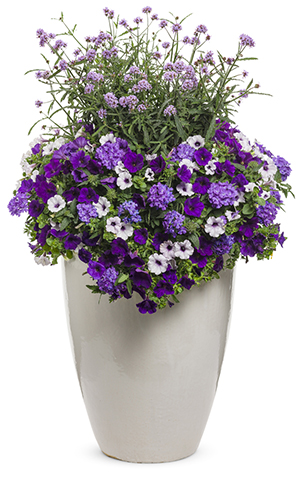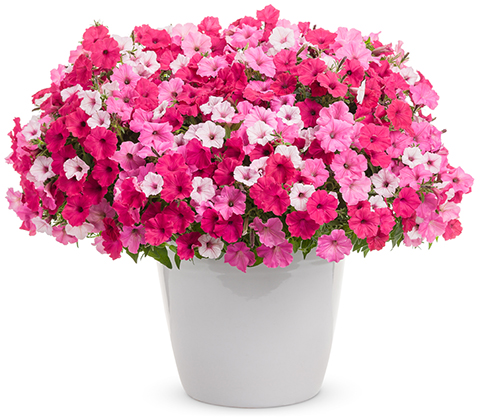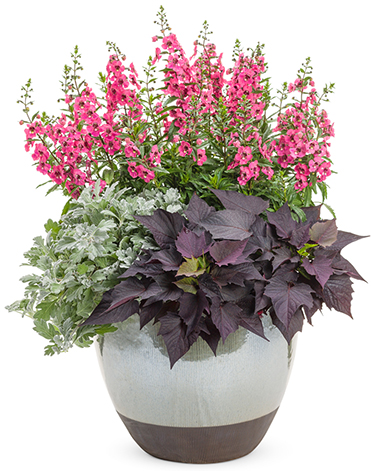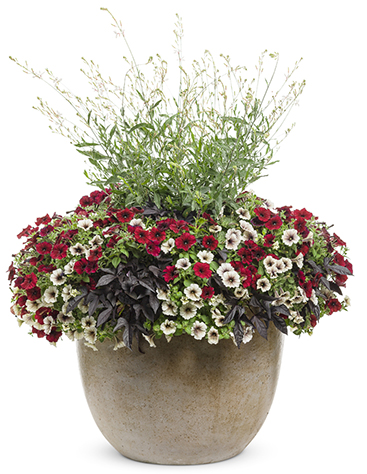Five Tips for Choosing Container Companions
You’ve seen gorgeous container recipes in pictures, but how do you get that look? It takes some time to learn how to design container combinations like a pro, but we have a few key tips that will prompt a successful start. Let’s take a look at five guidelines for choosing container companions.
How can you get exactly the look you want, in your preferred colors, for your patio containers? Plant them yourself! Growing impressive container plants becomes incredibly fun and easy once you learn a few key ground rules. Here’s how the pros do it.
#1 – Combine plants that prefer similar growing conditions. Rule #1 in gardening is to choose the right plant for the right place. Decide first where you will be placing your container once it is all planted up. Will it be in full sun, part shade or full shade? Full sun plants need at least six hours of direct sun per day, and generally prefer warm afternoon sun. Part shade plants need 4-6 hours of sun, while full shade plants will grow with less than four hours of sun exposure per day. Many garden centers separate their displays based on sun and shade requirements. Read the label before you buy to make sure you are choosing varieties that all enjoy a similar amount of sun. If you are choosing plants for a warm sunny spot, choose all full sun loving plants. Choose part shade to full shade plants if your container will be sited in a shadier place. Also, check the plant label to see how much water each plant prefers. Avoid pairing flowers that need consistently moist soil with those that are drought tolerant. Since they will be sharing soil in the same container, they will all receive the same amount of moisture. Be realistic. If you don’t plan to water often, choose all drought tolerant varieties. Pictured Here: Supertunia petunias, Superbena trailing verbena and Meteor Shower tall verbena all prefer full sun, average moisture, and similar amounts of fertilizer. Their similar growth rate also makes them a great match in this recipe named Lilac Festival. |
#2 – Choose plants with similar growth rates. This one can be a little tricky, and it’s where experience will be your guide. Not all plants grow at the same rate, regardless of how healthy they are. Some are bounding with energy and seem to grow an inch a day. Others are restrained and won’t increase much in size over the season. Most annual flowers grow at what we call an “average” rate, meaning they’ll grow all season without exceeding their allotted space. To make sure one plant won’t overtake the others in your container, choose varieties with similar growth rates. You could do this by pairing different colors of the same kind of plant—for example, planting three different colors of geraniums in one container. Also look for clues to the plant’s growth rate in its description. If it describes a “vigorous” plant that “grows quickly”, you’ll know it needs to be paired with other vigorous varieties that can keep up. Similarly, you wouldn’t pair something described as “petite” or “tightly mounded” with something that has a sprawling habit. If one plant in your container recipe grows too large compared to the others, trim its stems periodically to keep it in balance with the others. Make note of this so you’ll remember for next year. As you gain experience, you’ll get a good feel for which of your favorite plants make good companions for one another. Pictured Here: Since Supertunia Vista® petunias all share an extremely vigorous growth rate, they are a perfect match in this recipe named Above and Beyond.
Once you’ve mastered these first two guidelines, the rest are pure fun!
|
#3 – Use a variety of textures, shapes and sizes in your recipe. It’s time to mix things up! Contrast is the key to designing a sensational container recipe. Choose plants with a variety of different shaped leaves and flowers, some with larger leaves and others with finely textured ones. Choose a mix of thrillers, fillers and spillers to give some dimension to your container planting. Just be sure to follow guidelines 1 and 2 first when selecting plants. Pictured Here: The varying foliage colors, shapes and sizes of the plants in this recipe named Good Afternoon make it incredibly showy all season long. |
#4 – Purchase the right amount of plants for your container. The number of plants you’ll need to fill your container depends on several factors including the size of the pot, what size plants you are starting with, and how big they grow. Generally, a 10-12” container (measured across the top rim) can hold three 4” pot-sized plants. If you are starting with smaller plants from 6-packs, you’ll need double the number to fill the same container. If you are using a larger container, you’ll need more plants. Grouping the plants you’ve selected together on a bench at the store will give you a good visual of how many will fit in your container. Read the label to see how large each individual plant grows. You’ll need fewer wide-spreading, vigorous plants like Supertunia Vista® Bubblegum® petunias to fill your container than something more mounded in shape like Superbells® Tropical Sunrise calibrachoas. If you want your containers to look full quickly, perhaps for an upcoming event, start with larger sized plants or use more than you would typically. If you do so, keep in mind that some editing may be needed as the plants mature through the season. Start with fewer or smaller plants if you enjoy watching your containers fill out over time. Pictured Here: In a large container recipe like this one named Enchanted Garden, you could create instant impact by filling it with 7 or more plants. If you’re willing to wait a few more weeks for it to fill out, you could use just four plants. |
 #5 – Copy someone else’s great idea. When it comes to planning container recipes, it is completely acceptable to copy an idea you’ve seen and loved. Before you shop, consider what colors you might want to use this year. Maybe you’ll choose something that complements your patio furniture, or you’ll go bold and choose something completely new. Don’t be afraid to change things up from what you typically grow. Have fun with it! A great source of inspiration is our Container Gardening Recipe Search tool. Search by color scheme, container style, sun/shade requirements and more to find your favorite new recipes. Each one includes the plant list, how many of each plant you’ll need, and how to arrange them in the container. Save or print the recipe to bring with you when you shop. Once you’re at the store, you can also look at their pre-planted container recipes and copy them in your own colors. Ask a sales associate to help you identify the types of plants used in a recipe you like, then find them in the colors you prefer and pot up your own. Imitation is the sincerest form of flattery! Pictured Here: Copy this idea for a super-sized window box recipe called The Artist. |
Want to learn more about container gardening?
- Use our Container Gardening Recipe Search tool to explore 1000+ recipes.
- Read more container gardening articles.
- Watch container gardening videos on our YouTube channel.
- Explore our Pinterest board of container garden recipes.








